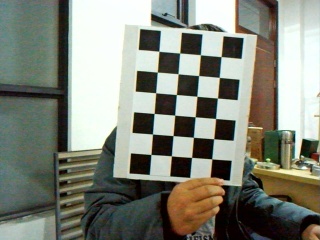python+openCV实现双目视差图及测距
通过matlab标定得到相机参数放到stereoconfig.py
import numpy as np import cv2 #双目相机参数 class stereoCameral(object): def __init__(self): #左相机内参数 self.cam_matrix_left = np.array([[249.82379, 0., 156.38459], [0., 249.07678, 122.46872], [0., 0., 1.]]) #右相机内参数 self.cam_matrix_right = np.array([[242.77875, 0., 153.22330], [0., 242.27426, 117.63536], [0., 0., 1.]]) #左右相机畸变系数:[k1, k2, p1, p2, k3] self.distortion_l = np.array([[-0.02712, -0.03795, -0.00409, 0.00526, 0.00000]]) self.distortion_r = np.array([[-0.03348, 0.08901, -0.00327, 0.00330, 0.00000]]) #旋转矩阵 om = np.array([-0.00320, -0.00163, -0.00069]) self.R = cv2.Rodrigues(om)[0] # 使用Rodrigues变换将om变换为R #平移矩阵 self.T = np.array([-90.24602, 3.17981, -19.44558])
视差图及三维坐标
import cv2 import numpy as np import stereoconfig def getRectifyTransform(height, width, config): #读取矩阵参数 left_K = config.cam_matrix_left right_K = config.cam_matrix_right left_distortion = config.distortion_l right_distortion = config.distortion_r R = config.R T = config.T #计算校正变换 if type(height) != "int" or type(width) != "int": height = int(height) width = int(width) R1, R2, P1, P2, Q, roi1, roi2 = cv2.stereoRectify(left_K, left_distortion, right_K, right_distortion, (width, height), R, T, alpha=0) map1x, map1y = cv2.initUndistortRectifyMap(left_K, left_distortion, R1, P1, (width, height), cv2.CV_32FC1) map2x, map2y = cv2.initUndistortRectifyMap(right_K, right_distortion, R2, P2, (width, height), cv2.CV_32FC1) return map1x, map1y, map2x, map2y, Q # 畸变校正和立体校正 def rectifyImage(image1, image2, map1x, map1y, map2x, map2y): rectifyed_img1 = cv2.remap(image1, map1x, map1y, cv2.INTER_AREA) rectifyed_img2 = cv2.remap(image2, map2x, map2y, cv2.INTER_AREA) return rectifyed_img1, rectifyed_img2 #视差计算 def sgbm(imgL, imgR): #SGBM参数设置 blockSize = 8 img_channels = 3 stereo = cv2.StereoSGBM_create(minDisparity = 1, numDisparities = 64, blockSize = blockSize, P1 = 8 * img_channels * blockSize * blockSize, P2 = 32 * img_channels * blockSize * blockSize, disp12MaxDiff = -1, preFilterCap = 1, uniquenessRatio = 10, speckleWindowSize = 100, speckleRange = 100, mode = cv2.STEREO_SGBM_MODE_HH) # 计算视差图 disp = stereo.compute(imgL, imgR) disp = np.divide(disp.astype(np.float32), 16.)#除以16得到真实视差图 return disp #计算三维坐标,并删除错误点 def threeD(disp, Q): # 计算像素点的3D坐标(左相机坐标系下) points_3d = cv2.reprojectImageTo3D(disp, Q) points_3d = points_3d.reshape(points_3d.shape[0] * points_3d.shape[1], 3) X = points_3d[:, 0] Y = points_3d[:, 1] Z = points_3d[:, 2] #选择并删除错误的点 remove_idx1 = np.where(Z <= 0) remove_idx2 = np.where(Z > 15000) remove_idx3 = np.where(X > 10000) remove_idx4 = np.where(X < -10000) remove_idx5 = np.where(Y > 10000) remove_idx6 = np.where(Y < -10000) remove_idx = np.hstack( (remove_idx1[0], remove_idx2[0], remove_idx3[0], remove_idx4[0], remove_idx5[0], remove_idx6[0])) points_3d = np.delete(points_3d, remove_idx, 0) #计算目标点(这里我选择的是目标区域的中位数,可根据实际情况选取) if points_3d.any(): x = np.median(points_3d[:, 0]) y = np.median(points_3d[:, 1]) z = np.median(points_3d[:, 2]) targetPoint = [x, y, z] else: targetPoint = [0, 0, -1]#无法识别目标区域 return targetPoint imgL = cv2.imread("_left.jpg") imgR = cv2.imread("_right.jpg") height, width = imgL.shape[0:2] # 读取相机内参和外参 config = stereoconfig.stereoCameral() map1x, map1y, map2x, map2y, Q = getRectifyTransform(height, width, config) iml_rectified, imr_rectified = rectifyImage(imgL, imgR, map1x, map1y, map2x, map2y) disp = sgbm(iml_rectified, imr_rectified) cv2.imshow("disp", disp) target_point = threeD(disp, Q)#计算目标点的3D坐标(左相机坐标系下) print(target_point)






